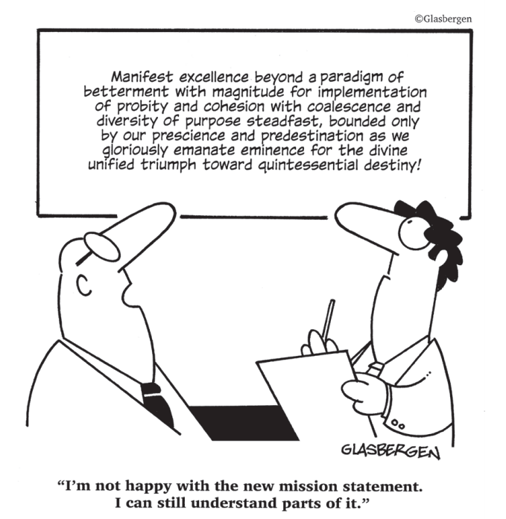How Could We Go So Wrong With Something So Important?
 Derek & Laura Cabrera
·
1 minute read
Derek & Laura Cabrera
·
1 minute read
This post is an excerpt from Chapter 2 of Flock Not Clock.
There’s a reason that there are articles in Inc. titled “The 9 Worst Mission Statements of All Time” and “Why Most Mission Statements Suck So Bad.”
Weird Al Yankovic has a song titled “Mission Statement”(using biz jargon from the statements of real companies). A Google search for “mission statement cartoon” yields 4,600,000 results (without even specifying images). The Google search “I hate mission statements” returns about 398,000 results. It is near obligatory when discussing mission statements (even among proponents) to point out their shortcomings.
• “Ninety-nine percent of the mission statements out there are useless.”
• “...if you want to read some good fiction and wonder what the heck some departments think their purpose is, check out random department websites and look at some mission statements.”
• “[Mission statements] are the product of untold man-hours of ‘brainstorming’ and ‘focus-grouping’ resulting in the blandest, most generalized, least potentially offensive, frequently asinine copy that could have been created by any group of monkeys in any boardroom in America.”
 Figure 3.1: Are we trying to make them bad?
Figure 3.1: Are we trying to make them bad?
What should we expect when missionstatements.com will draft a mission statement within 24 hours for your organization for $35? Their five-step wizard asks questions like, “What are some specific actions that your company has taken (or will take) that makes a significant difference to your customers?” Although we think there are rules that should guide the creation of a mission, the formulaic, borderline-meaningless, dime-a-dozen mission statements out there are giving the idea of mission—which is essential to every organization—a bad name.
This is both tragic and dangerous. We’re with Peter Drucker, who wrote, “that business purpose and business mission are so rarely given adequate thought is perhaps the most important cause of business frustration and failure.”
.png?width=150&height=150&name=CRL%20GOAT%20Logo%20(4).png)



